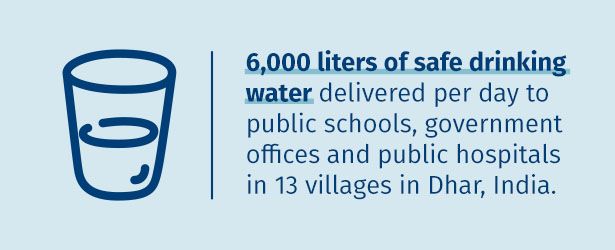Safe drinking water: An unlikely antidote for malnutrition
Published on by Water Network Research, Official research team of The Water Network in Case Studies
One community-led solution, brought to life by like-minded stakeholders, is showing great promise in arresting malnutrition rates, by providing access to safe drinking water in Madhya Pradesh. But how and what’s next? A small village in the water-scarce tribal district Dhar holds all the answers.
Medha* awaits the water delivery vehicle that arrives every day at the public elementary school in Nalchha, Dhar, where she teaches Geography. This week, she oversees receiving, counting, logging, and storing the water cans that are earmarked for the students at her school. It makes her happy that children receive not only wholesome supplementary meals via the mid-day meal program but also safe drinking water, which has a huge role to play in reducing malnutrition.
Medha pays a little over INR 300 (~US$4) to the water couriers who unload a couple of dozen cans (US$0.18 for 20 liters each) of safe drinking water in the school shed. This water has been processed at the new water treatment plant (CWTP) set up under the guidance of the District Administration and Public Health Engineering Department, Dhar.
Medha sounds the gong for the mid-day meal as the water delivery vehicle makes its way across the village, delivering safe drinking water to households and other institutions in one of India’s most water-stressed districts.
Integrating agenda, approach, and action
At a time when temperatures are rising and wells/handpumps are drying up, the need for diversity of water sources, especially for drinking purposes, is extremely critical. In Madhya Pradesh (MP), which is currently plagued by the double burden of anemia and malnutrition, it is also an important enabler in achieving the state’s nutritional goal.

Since the inception of the nutrition program in 2016, CHAI has always underlined the importance of access to safe drinking water to improve the nutritional status of communities in MP. Drinking untreated groundwater with high levels of fluoride, iron, arsenic, or other chemical contaminants often leads to conditions such as fluorosis, and may also lower the body’s nutrient absorption capabilities. Further, drinking untreated water amplifies the chances of contracting acute water-borne diseases like diarrhea, typhoid, jaundice, and cholera.
As part of its People-Powered Newtrition initiative, CHAI stepped forward to support the Government of MP (GoMP) in mitigating the risks posed by a lack of access to safe drinking water by identifying community-level solutions. Since 2018, CHAI has provided extensive support towards developing a sustainable model for community water treatment plants (CWTP).
Given the direness of the situation in Dhar, CHAI reached out to the district administration to help set up a pilot water purification plant in the village of Nalchha. From identifying site and entrepreneur to overseeing the construction of the plant and mentoring the rural entrepreneur, CHAI — in association with like-minded partners like TATA Trusts and Drinkwell Technologies — was able to create an easily replicable model, drawing knowledge from available good practices. For instance, it was decided to use more efficient resin-based nanotechnology for the plant, rather than energy-intensive conventional technologies. The selected technology also led to lesser wastage of water during treatment and longer life of the plant.
A multipurpose project
The concept of community water treatment plants (CWTPs) was driven by the larger idea that delivering safe drinking water for millions at a nominal cost could also generate sustainable livelihoods for local communities.
CHAI played an instrumental role in creating a unique entrepreneurship model. Under this, a local farmer turned entrepreneur was identified and trained in streamlining business operations and identifying and implementing efficiencies, in a bid to raise local accountability and ownership of the plant. Further, CHAI proposed a co-ownership and co-investment model wherein the capital expenditure is partially borne by CHAI and TATA Trusts, while the remaining capital expenditure and operational costs are borne by the entrepreneur through a loan, subsidized by the government.
The plant is designed to deliver approximately 6,000 liters of safe drinking water per day to public schools, government offices, Anganwadi (community health) centers, and public hospitals across 13 villages in Dhar. The pilot plant set up in November 2018 has, in three years, already generated US$22,900 in revenue, while making an operating profit of US$4,000, a part of which has been reinvested in the facility for further improvement.
Moreover, for the community, besides receiving clean water, doorstep delivery has enabled many to save a lot of time and energy and spend it in other productive activities.
Impressed by the success of the existing plant, the Public Health Engineering Department (PHED), GoMP, under the ambit of their flagship Jal Jeevan Mission, is scaling up this model in other quality-affected geographies of the state. To streamline the scale-up effort, CHAI has been roped in as a resource organization providing technical and program management support.
As a step further, PHED intends to leverage the existing self-help groups and their federations for operationalization support for the upcoming CWTPs.
Hailed as a “champion of health” by Medha and other residents of Nalchha, the community-led plant serves as a reminder of what holistic development can look like. We learn that by strengthening local systems, a transformational change can be brought about by and for the community, and that access to safe drinking water, and in turn, nutritional goals can be met.
Author: Mansharan Seth, Deputy Director, Nutrition and Sexual and Reproductive Health, India
Taxonomy
- Public Health
- Nutraceuticals
- Health and Welfare
- Nutritionist
- Public Health